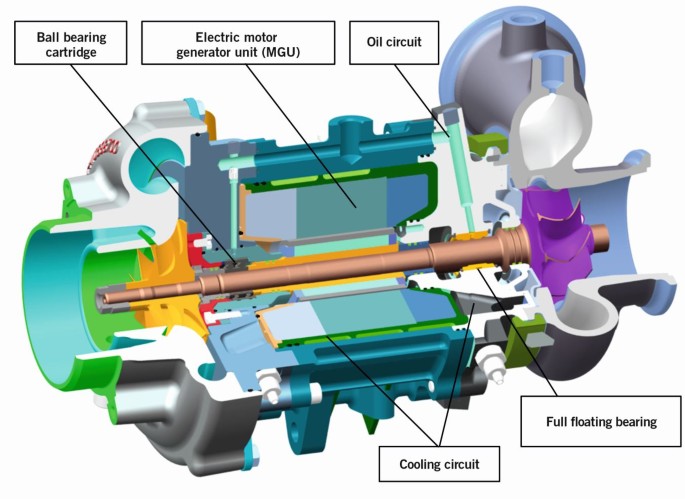PlatinumZealot wrote: ↑09 Mar 2020, 15:14
saviour stivala wrote: ↑09 Mar 2020, 07:42
The turbocharger (Turbine) safe maximum RPM depends on the turbine diameter (tip blades speed). If the rotational speed (RPM) of the MGU-H being used is the maximum permitted (125000rpm) and the maximum rotational speed (RPM) of the turbocharger being used is less, the MGU-H have to be geared at the appropriate ratio. Example: MGU-K max rpm 50000 to crankshaft max rpm 15000 (and also may be clutched). This fixed speed ratio is achieved through the use of a tiny planetary gearbox, in the case of the split-turbo set-up with the MGU-H sitting in between the turbine and compressor, the gearbox would be at one end of MGU-H hollow drive/input shaft which the turbine/compressor shaft is passing through. And a sprag-type of one-way clutch will be the simplest and least complicated type of clutch to use.
Now you are saying “why not simply use the same shaft? And take that same shaft the armature of the electrical (as Garret does).”. What you are saying implicates that the rotating element (armature of MGU-H) is a one-piece-shaft with the turbine and compressor wheels fixed at each end. And rotating as a direct-drive (ratio 1:1). No gearbox ratio up or down and no clutch. On the other hand according to your calculations (06 March) the bigger more efficient turbos being used, which are supposed to push more air at lower RPM, are estimated spinning at around a maximum of 85000rpm at full boost. Contrast that with what Bandid 1216 said: “One more thing, high RPM is the key to design high power to weight ratio electrical motor/generator. Otherwise the MGU-H would be big and heavy. So one wants the turbo as low RPM as possible, but the MGU-H as high RPM as possible".
I am sorry you didn't see the photos and videos I painstakingly posted. The video on the page was technician testing the electrical properties of the armature on the turbine shaft. I can't convince you, I was just showing you an actual real life MGUH made by probably the biggest Turbo- manufacturer in the world.
Here is more for those interested,
No clutch in sight...
https://www.researchgate.net/publicatio ... velopments
https://www.researchgate.net/profile/Da ... isting.png
In one such application, the electrical machine is placed on
the same shaft as the turbine and the compressor wheels in
a turbocharger (machine M1 in Fig. 1). The function of the
machine is twofold. On starting and gear shift, when there is
lack of energy in the exhaust gas stream, the machine is used as
a motor to speed up the compressor to the required speed, thus
reducing turbo lag and improving driveability. At high engine
loads, when there is excess energy in the exhaust, instead of
opening a waste-gate valve to prevent shaft overspeeding, the
electrical machine is used as a generator. The typical integra-
tion of the electrical machine within a turbocharger is shown
in Fig. 2
https://media.springernature.com/lw685/ ... 1_HTML.jpg
I'm still amazed that because this exists for a road car application, you think this is the limit for the F1 power units and use said turbo like it's a confirmation it's impossible/otherwise pointless..
You are completely sidestepping the fact the F1 power units have regulations enforced that require lateral thinking design and technology wise to get to a certain goal.
I actually said I agree with you there would be zero application/woould have no benefit for a clutched MGU-H in a road car application, mainly because my suggestion of a clutch was to sidestep a regulation in Formula 1 (obviously this is NOT OF A CONCERN for road car use).
What confuses me further is you keep relating it to electric cars and or repeating how this Garrett design works. Mate, I and most likely a few others know what you keep linking and understand fully what Garrett have come up with, the question on my mind is why are you doing it? Because it's overall idea is similar? Because it has an electric motor? Because THIS has no clutch it cannot be possible elsewhere? Because it has the word turbo in it?
Because you're the one "painstakingly posting" information/descriptions of which nobody is asking lol. At this point you may as well post articles on the debate as to whether Elephants feel empathy towards each other...
If banging your head against the wall is hurting, just a thought, maybe stop, realise there was no need to do that in the first place..




